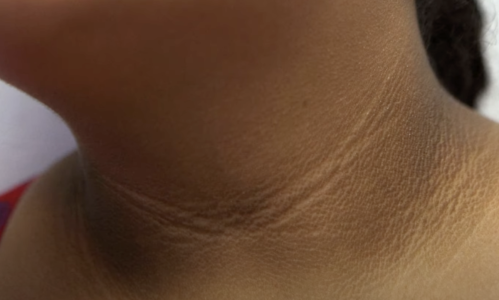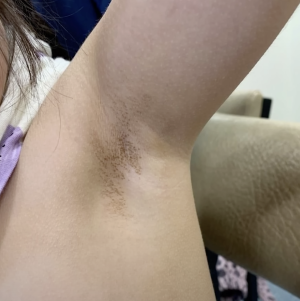
When dark, velvety patches start appearing around the neck, many people assume it’s just dirt that won’t wash off. But when scrubbing doesn’t help, it may be a sign that something else is going on. These skin changes can actually serve as an early warning system—one that could help prevent a serious health condition from developing.
These mysterious dark patches, known medically as acanthosis nigricans, are more common than you might think and could be your body's way of signaling that your blood sugar levels need attention.
"High insulin usually doesn't cause symptoms you can feel right away, and that's what makes it tricky"
Also read: Ten patients, no more insulin—are we getting closer to curing diabetes?
The hidden connection between your skin and blood sugar
Acanthosis nigricans affects 19.5% of adults in the United States, making it far more prevalent than most people realize.
What's particularly striking is that those with this skin condition are twice as likely to have type 2 diabetes compared to those without it—35.4% versus 17.6%.
Given that 38.4 million Americans of all ages have diabetes, with 90 to 95 percent having type 2, and an additional 8.7 million adults meet the criteria for diabetes but are unaware of it, recognizing these early warning signs becomes crucial for prevention and early intervention.
What to look for: Acanthosis nigricans warning signs
The main signs are dark, thick, velvety skin in body folds and creases, often appearing in the armpits, groin and back of the neck.
The affected skin might be itchy, have an odor and develop skin tags.
The patches develop slowly over time and won't wash off with soap and water.
Also read: Is processed meat riskier than soda? Here’s what new research says about your diabetes risk
Understanding what's happening beneath the surface
The development of acanthosis nigricans isn't random—it's your body responding to internal changes that you might not yet feel.
Most people who have acanthosis nigricans have also become resistant to insulin, the hormone that helps your body process sugar from food.
When you consume too much sugar over time, your body produces more insulin to keep blood sugar levels stable.
This excess insulin doesn't just affect your internal organs—it also activates certain skin cells that have insulin receptors, leading to the characteristic dark, thickened patches.
Who's most at risk?
While anyone can develop acanthosis nigricans, certain groups face higher risks.
People of Native American, African, Caribbean, or Hispanic descent are more susceptible to the condition.
Additionally, a study of adults with obesity found that of those who weighed double their ideal body weight, at least 50% showed signs of acanthosis nigricans.
Age also plays a role, as insulin resistance tends to increase over time, making it particularly important for older adults to be aware of these warning signs.
Did you know?
Did you know?
The condition isn't just a cosmetic issue—it’s actually your body’s early warning system. Unlike many diabetes symptoms that appear later in the disease process, acanthosis nigricans can develop during the prediabetes stage, giving you valuable time to take preventive action.

Also read: The overlooked drink that can help you stay hydrated with diabetes, say dietitians
The silver lining—it’s often reversible
Here’s the encouraging news: acanthosis nigricans isn’t permanent.
If the underlying cause can be addressed, such as through weight loss interventions, then the acanthosis nigricans is expected to improve or fully resolve.
This means that lifestyle changes focused on improving insulin sensitivity can not only help prevent type 2 diabetes but also restore your skin to its normal appearance.
The key is addressing the root cause rather than just treating the skin symptoms.
Also read: Could this simple diet trick lower your blood pressure—even if you have diabetes?
Taking action—your next steps
If you notice dark, velvety patches on your skin, don’t panic, but don’t ignore them either.
The first step is scheduling an appointment with your healthcare provider for proper evaluation.
They may recommend blood tests to check your glucose and insulin levels.
Early detection is particularly valuable because prediabetes—the stage before type 2 diabetes—can often be reversed through lifestyle modifications.
This includes regular physical activity, reducing processed foods in your diet, managing stress levels, and achieving a healthy weight.
Also read: You’re probably not getting enough of this diabetes-fighting nutrient
Managing the condition and your health
Even if you do develop type 2 diabetes, it’s important to understand that the condition can often go into remission.
As diabetes experts explain, remission occurs when blood sugar levels fall below the diabetes range and stay there for at least three months without glucose-lowering medication.
While remission doesn’t mean the diabetes has permanently disappeared, it does mean that with proper lifestyle management, you can pause the progression and symptoms of the disease.
Essential action steps for acanthosis nigricans
- Check your skin regularly, especially around the neck, armpits, and groin areas
- Don’t try to scrub the patches away—they won’t come off with washing.
- Schedule a medical evaluation if you notice new dark, velvety skin patches
- Request blood sugar and insulin testing from your healthcare provider
- Focus on lifestyle changes: regular exercise, healthy eating, weight management
- Remember that early detection gives you the best chance for reversal
Also read: Urgent warning for some insulin pump users: What you need to know right now
A hopeful perspective on prevention
The discovery of acanthosis nigricans on your skin isn’t a cause for alarm—it’s actually an opportunity.
Unlike many health conditions that develop silently, your skin is giving you visible advance notice that changes are needed.
With proper medical guidance and commitment to healthier lifestyle choices, many people successfully reverse both the skin condition and the underlying insulin resistance that causes it.
The key is recognizing these early warning signs and taking proactive steps before more serious complications develop.
What This Means For You
Your skin serves as an early warning system for your overall health—and that’s actually a gift.
By paying attention to these signals and working with your healthcare provider, you can take control of your health before more serious symptoms develop.
Read next:
- Could this vitamin play a role in lowering blood sugar?
- Are you at risk? The “silent” liver condition that could quietly strain your heart
- This meal trick has people rethinking how they eat
What skin changes have you noticed that turned out to be important health indicators? Share your experiences in the comments below—your story might help another reader recognize their own early warning signs.
Primary Source
https://www.independent.co.uk/life-style/diabetes-signs-symptoms-sugar-high-b2844150.html
Acanthosis Nigricans: Causes, Diagnosis, and Treatment
Cited text: Acanthosis nigricans was found in 18.2% of children and 19.5% of adults in a cross-sectional study (n=1730) in the United States.
Excerpt: Acanthosis nigricans affects 19.5% of adults in the United States
https://dermnetnz.org/topics/acanthosis-nigricans
Acanthosis Nigricans: Causes, Diagnosis, and Treatment
Cited text: Those diagnosed with AN were twice as likely to have type 2 diabetes compared to those without (35.4% vs. 17.6%).
Excerpt: those with this skin condition are twice as likely to have type 2 diabetes compared to those without it - 35.4% versus 17.6%
https://dermnetnz.org/topics/acanthosis-nigricans
Doctors reveal important warning sign that you’re consuming too much sugar
Cited text: According to the 2024 National Diabetes Statistics Report, 2021 data found that 38.4 million Americans of all ages had diabetes, with 90 to 95 percent...
Excerpt: 38.4 million Americans of all ages have diabetes, with 90 to 95 percent having type 2
https://ca.style.yahoo.com/doctors-reveal-important-warning-sign-185959957.html
Doctors reveal important warning sign that you’re consuming too much sugar
Cited text: An additional 8.7 million adults aged 18 years or older met the criteria for diabetes but were either unaware or did not self-report having it.
Excerpt: an additional 8.7 million adults meet the criteria for diabetes but are unaware of it
https://ca.style.yahoo.com/doctors-reveal-important-warning-sign-185959957.html
Acanthosis nigricans: Treating underlying disorders may improve skin condition-Acanthosis nigricans - Symptoms & causes - Mayo Clinic
Cited text: The main sign of acanthosis nigricans is dark, thick, velvety skin in body folds and creases. It often appears in the armpits, groin and back of the n...
Excerpt: The main signs are dark, thick, velvety skin in body folds and creases, often appearing in the armpits, groin and back of the neck
https://www.mayoclinic.org/diseases-conditions/acanthosis-nigricans/symptoms-causes/syc-20368983
Acanthosis nigricans: Treating underlying disorders may improve skin condition-Acanthosis nigricans - Symptoms & causes - Mayo Clinic
Cited text: The affected skin might be itchy, have an odor and develop skin tags.
Excerpt: The affected skin might be itchy, have an odor and develop skin tags
https://www.mayoclinic.org/diseases-conditions/acanthosis-nigricans/symptoms-causes/syc-20368983
Acanthosis nigricans: Treating underlying disorders may improve skin condition-Acanthosis nigricans - Symptoms & causes - Mayo Clinic
Cited text: Most people who have acanthosis nigricans have also become resistant to insulin.
Excerpt: Most people who have acanthosis nigricans have also become resistant to insulin
https://www.mayoclinic.org/diseases-conditions/acanthosis-nigricans/symptoms-causes/syc-20368983
Acanthosis Nigricans: Causes, Diagnosis &Treatment
Cited text: Are of Native American, African, Caribbean or Hispanic descent.
Excerpt: People of Native American, African, Caribbean or Hispanic descent
https://my.clevelandclinic.org/health/diseases/12168-acanthosis-nigricans
Acanthosis Nigricans: Causes, Diagnosis &Treatment
Cited text: However, a study of adults with obesity found that of those who weighed double their ideal body weight, at least 50% showed signs of acanthosis nigric...
Excerpt: a study of adults with obesity found that of those who weighed double their ideal body weight, at least 50% showed signs of acanthosis nigricans
https://my.clevelandclinic.org/health/diseases/12168-acanthosis-nigricans
Acanthosis Nigricans: Causes, Diagnosis, and Treatment
Cited text: If the underlying etiology can be addressed, such as through weight loss interventions, then the acanthosis nigricans is expected to improve or fully ...
Excerpt: If the underlying cause can be addressed, such as through weight loss interventions, then the acanthosis nigricans is expected to improve or fully resolve
https://dermnetnz.org/topics/acanthosis-nigricans







